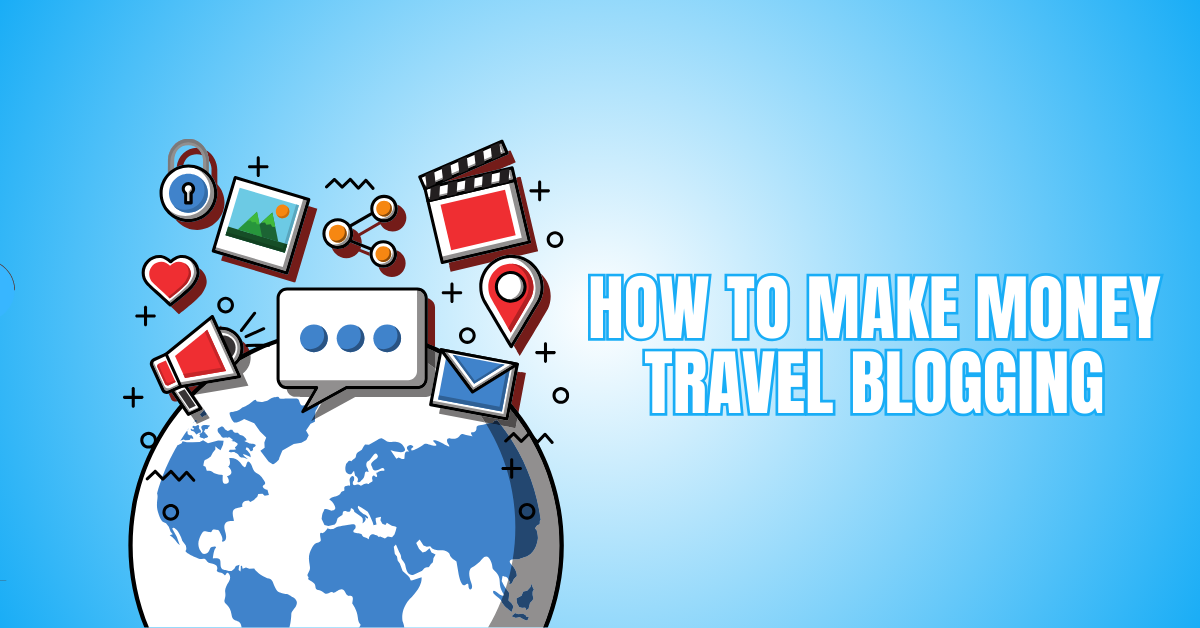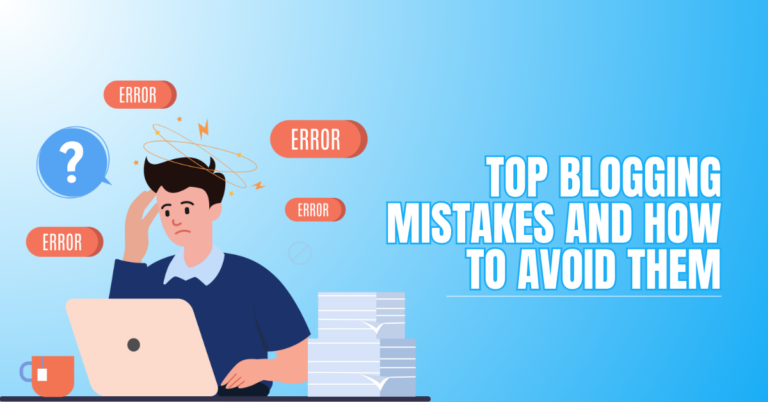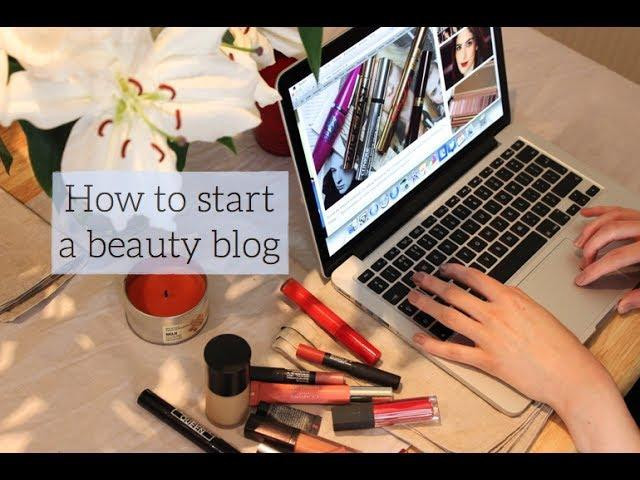Ultimate Guide On How To Make Money Travel Blogging
Dreaming of turning your travels into income? You’re not alone! Many adventurers are learning how to make money travel blogging and living a life they love.
Whether you are starting from scratch or ready to level up, this guide shares proven methods to grow your blog and bank account. Get ready to explore the world and earn along the way—it’s more possible than ever!
Steps To Monetize A Travel Blog
1. Start With A Professional Blog Website
To make money blogging, your first step is to create a self-hosted, professional blog. Choose a unique, niche-related domain name (e.g., “SoloNomadAdventures.com”) that reflects your travel style.
Purchase the domain through Namecheap or GoDaddy and select reliable web hosting like SiteGround or Bluehost. Install WordPress.org for maximum flexibility and SEO control.
Choose a mobile-responsive, clean theme like Astra or OceanWP. Essential plugins include Rank Math for SEO, WP Rocket for speed optimization, and Pretty Links for affiliate tracking.
Set up legal pages (Privacy Policy, Disclaimer, About Me) and start with a few core content pages. Your blog should immediately communicate value and trust to both readers and potential sponsors.
2. Choose A Profitable Travel Niche
By choosing a travel niche, you can improve your chances of making money, standing out, and attracting a devoted following.
Instead of broad travel content, focus on a niche such as budget travel, solo female travel, vegan travel, digital nomad lifestyle, or sustainable tourism.
Use tools like Google Trends and Ubersuggest to evaluate the popularity and competitiveness of niche topics. Create 3-5 content pillars within your niche, like “Packing Tips,” “Accommodation Reviews,” and “Budget Hacks,” and plan future content around them.
This helps you build topical authority and improve SEO. A focused niche builds trust, enhances affiliate conversions, and enables you to attract sponsors targeting that demographic.
3. Create High-Quality And SEO-Optimized Content
Content is your blog’s foundation. Write long-form, informative posts (1,200–2,000+ words) targeting keywords with decent search volume and low competition.
Use keyword research tools like KeySearch, Ahrefs, or Ubersuggest. Structure your post with headers, bullet points, optimized images (using TinyPNG), and internal links.
Include a clear call-to-action (CTA) and make your post visually engaging using Canva or Adobe Express for infographics. Install Grammarly to ensure flawless grammar.
Focus on evergreen content—like “How to Travel Southeast Asia on a Budget”—that will stay relevant over time. SEO-friendly content drives consistent organic traffic, critical for monetization strategies like ads and affiliate links.
4. Monetize With Display Advertising
Display ads are a passive income stream once your blog gains traction. Begin with Google AdSense or Ezoic once you hit 5,000–10,000 monthly sessions.
Use Google Site Kit to integrate your blog with AdSense and Analytics. As your traffic grows, apply to premium ad networks like Mediavine (50,000 sessions/month minimum) or Raptive.
Focus on creating high-RPM content—posts that attract valuable advertisers, such as travel insurance reviews or luxury destination guides.
Optimize ad placements without hurting user experience by testing different layouts using Ezoic’s built-in tools. Use heatmaps like Hotjar to analyze behaviour and improve your design for ad performance.
5. Use Affiliate Marketing To Recommend Travel Products
Affiliate marketing involves earning commissions by promoting travel products and services. Join programs like Booking.com, Amazon Associates, GetYourGuide, or World Nomads.
Use Pretty Links to create branded, trackable URLs. Create content that naturally includes affiliate links, like “Best Carry-On Backpacks for Digital Nomads” or “Top Travel Insurance Plans Compared.”
Be transparent with disclosures and focus on solving problems rather than hard-selling. Use comparison tables, product reviews, and resource pages to boost conversions.
Track your top-performing links using affiliate dashboards and optimize those posts regularly. Over time, affiliate income becomes a significant revenue stream, especially from evergreen posts with high search intent.
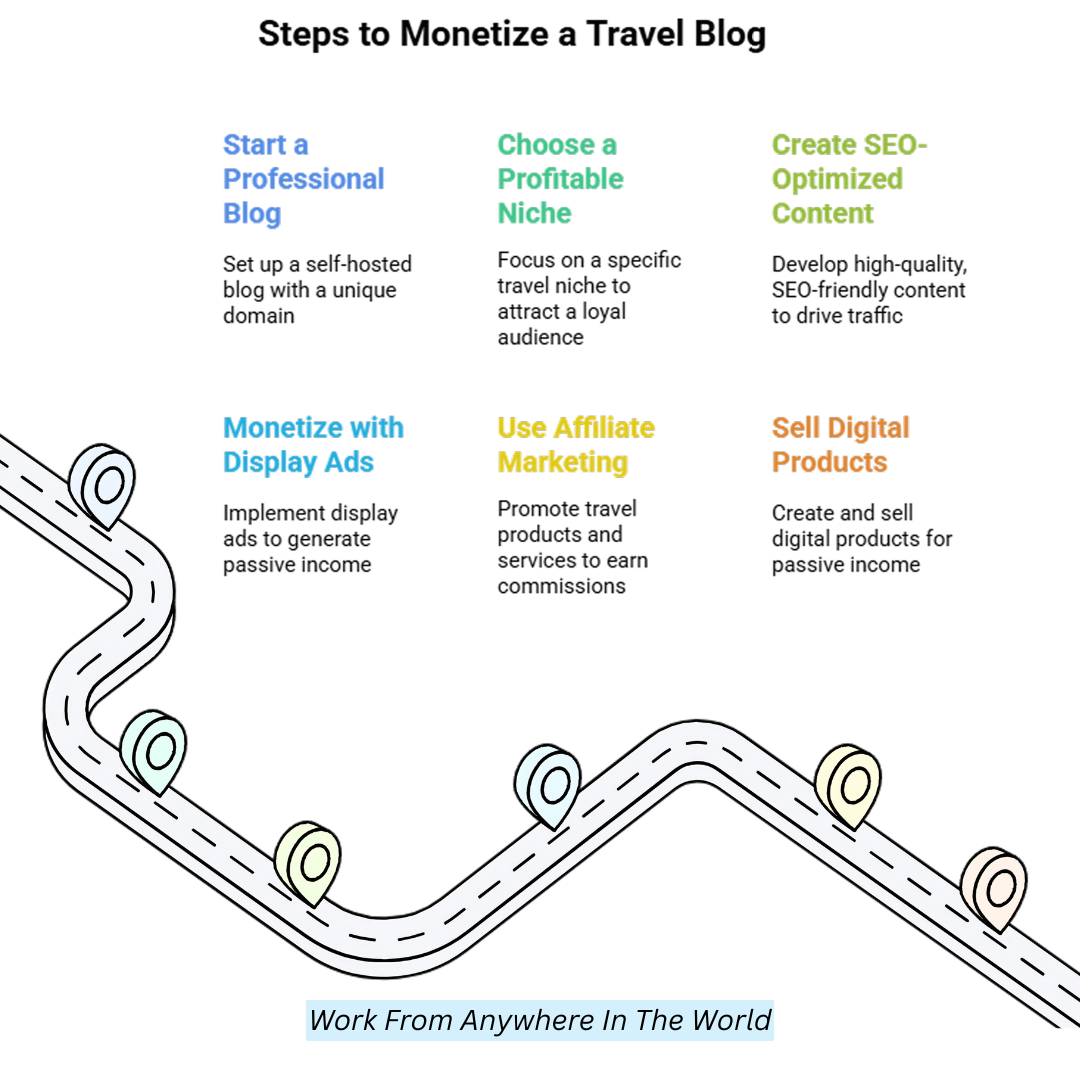
6. Sell Digital Products For Passive Income
Digital products like travel planners, budget spreadsheets, Lightroom presets, or eBooks can be sold directly from your blog using Gumroad, Podia, or WooCommerce.
Begin by identifying what your audience struggles with—e.g., “confused about packing for Europe.” Create a product to solve that issue and design it with Canva or Adobe InDesign.
Price it reasonably ($9–$27) and promote it via blog posts, pop-ups, and your email list. Offer bundle deals or upsells to increase order value.
Automate delivery and payments for actual passive income. These products scale well and work exceptionally well with niche-specific problems.
7. Launch A YouTube Channel Or Travel Vlog
A YouTube channel helps you reach a broader audience and earn from video ads, sponsors, and affiliate links. Start by repurposing blog content into video format using scripts and outlines.
Record using a quality smartphone or DSLR and a lapel mic for clear audio. Edit with CapCut or Adobe Premiere Pro. Optimize each video’s title, tags, and thumbnail using TubeBuddy or VidIQ. Link your blog in descriptions and drive viewers to your email list.
You can monetize via YouTube ads once you reach 1,000 subscribers and 4,000 watch hours. Video also improves trust and authority, key to building a strong brand.
8. Get Paid For Press Trips And Travel
Campaigns and Press trips are sponsored experiences by tourism boards or brands in exchange for content creation. Build your blog with consistent, high-quality posts and an engaged audience before pitching. Create a “Work with Me” page and media kit.
Use Notion to organize your outreach and Hunter.io to find tourism board contacts. Pitch a unique angle—like “How to Experience X on a Budget”—and specify deliverables.
Tag relevant tourism boards in social posts to get on their radar. Always overdeliver and send a post-campaign report with reach, engagement, and traffic stats to encourage future collaboration.
9. Offer Freelance Writing And Travel Services
Travel bloggers supplement their income with freelance work. Offer SEO travel articles, itinerary planning, travel consulting, or Pinterest management.
Create a “Services” page with packages and rates. Use tools like Trello to manage clients and Grammarly to polish submissions.
Join platforms like Upwork, Freelancer, or LinkedIn to find gigs. Showcase writing samples on your blog and pitch travel websites with guest post ideas.
Freelancing is a great way to earn a steady income while building your blog and professional reputation. It also positions you as an authority and improves your writing quality across your own content.
10. Create And Sell Online Courses
If you’ve mastered a skill, such as travel photography, planning trips on a budget, or blogging itself, consider creating an online course.
Use platforms like Teachable, Thinkific, or Kajabi to build and sell your course. Start with outlining key lessons, recording videos, and preparing worksheets.
Use Zoom or Loom to record lessons. Validate your course idea with your audience before launching. Price it competitively ($49–$299 depending on value) and offer bonuses like checklists or coaching.
Promote it via email, blog posts, and webinars. Courses generate high-ticket passive income and elevate your brand as an expert.
11. Promote Your Blog Through Social Media
Use platforms like Instagram, Pinterest, and TikTok to grow your audience and drive traffic. Choose one or two platforms to focus on.
Use Canva to create graphics and Later or Buffer to schedule posts. On Instagram, post travel reels, behind-the-scenes stories, and carousel tips.
On Pinterest, design vertical pins (1000x1500px) linking to blog posts. Engage with followers through comments and polls. Use hashtags strategically and collaborate with other creators.
Social media increases blog visibility, builds community, and opens new monetization opportunities like brand collaborations or paid posts.
12. Use Analytics To Track And Improve Performance
To monitor the effectiveness of your blog, use Google Analytics and Google Search Console. Set conversion goals, track page views, bounce rate, and traffic sources.
Use this data to understand which posts generate the most revenue (affiliate clicks, ad views, email signups). Tools like Hotjar provide heatmaps showing where users click, helping optimize the layout.
Ubersuggest and Ahrefs help you identify content gaps and improve SEO. Regular analysis allows you to double down on what’s working and revise underperforming content. This strategy-driven growth boosts traffic and income steadily.
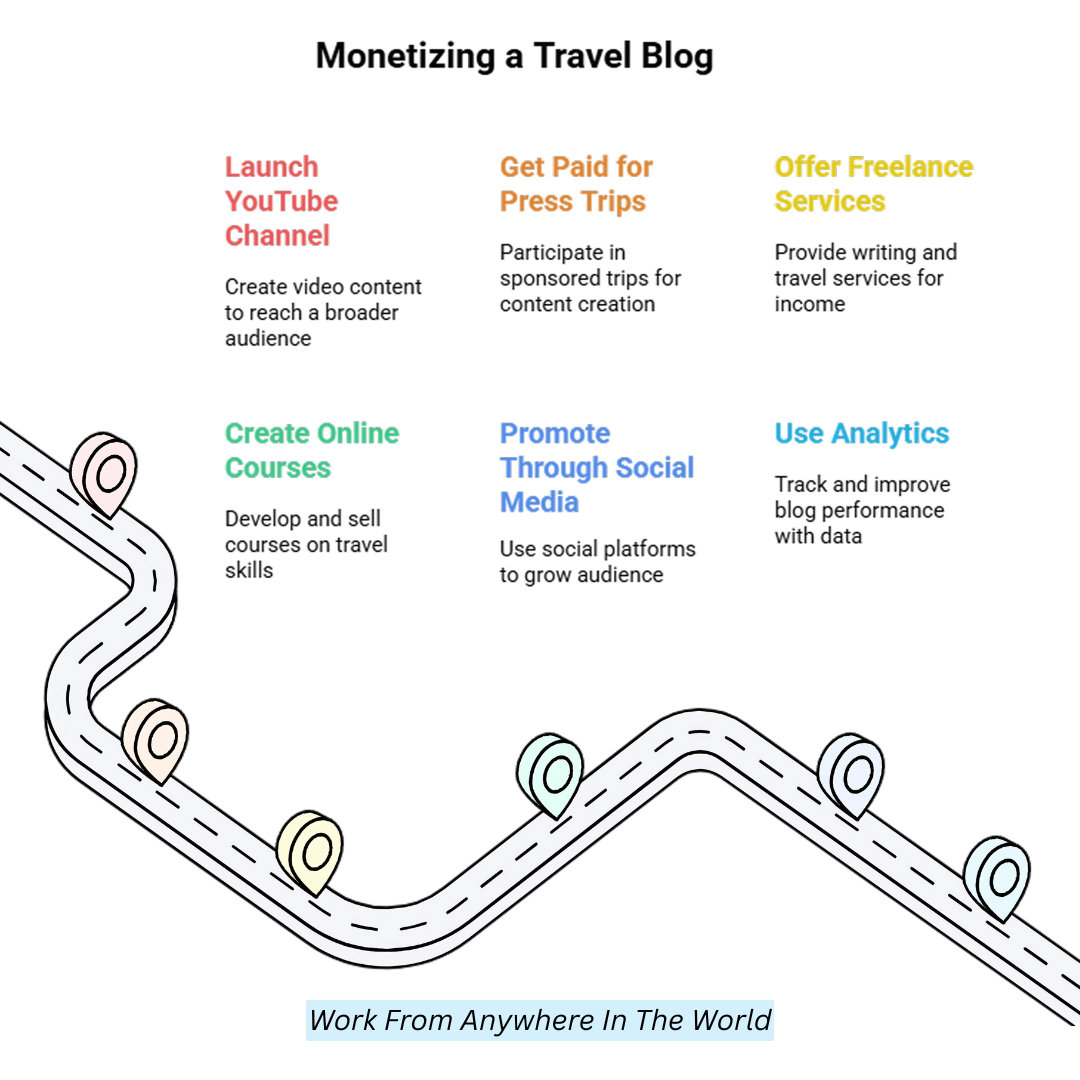
Essential Tools And Resources For Travel Bloggers
Starting a travel blog requires more than passion — you need the right tools and resources to create, promote, and grow your blog efficiently. Here are 10 essentials every travel blogger needs.
1. Blogging Platform
A blogging platform is where you publish your travel stories. WordPress.org is the most popular for flexibility and SEO, and it is ideal for serious bloggers.
Wix and Squarespace offer easy drag-and-drop builders, which are great for beginners with less tech knowledge. Setup involves creating an account, choosing a theme, and customizing.
WordPress requires hosting separately. Costs vary: WordPress hosting starts around $3–10/month; Wix and Squarespace range from $12–30/month.
Using a reliable platform ensures your blog runs smoothly and looks professional, helping attract and retain readers.
2. Domain & Hosting
Your domain is your blog’s web address; hosting is where your blog lives online. Buying a custom domain (around $10–15/year) makes your site look professional and easy to remember.
Hosting services like Bluehost or SiteGround provide storage and bandwidth to keep your site accessible. Setup involves purchasing the domain and hosting, connecting them, and installing WordPress if needed.
Depending on features, hosting plans typically cost $3–12/month. Having your domain and reliable hosting helps ensure your blog loads quickly and stays online consistently, improving user experience and SEO.
Wealthy Affiliate – Mini Review (2025)
If you’ve ever thought about turning your blog, passion, or niche into an online business,
Wealthy Affiliate (WA) is one of the most beginner-friendly platforms I’ve used.
It combines step-by-step training, website hosting, SEO research tools,
and an active community all in one place.
What I like most: you can start free (no credit card needed),
explore lessons, test the tools, and connect with other entrepreneurs
before upgrading. WA isn’t a “get rich quick” scheme — it’s a platform where success comes
from consistent effort and applying what you learn.
3. Content Creation Tools
Tools like Google Docs or Microsoft Word help you draft and edit posts anywhere, making writing flexible and convenient.
Grammarly checks grammar and spelling to polish your content professionally. Canva allows you to create stunning blog graphics, headers, and social media posts, even without design skills. Adobe Lightroom or Snapseed are powerful for photo editing to enhance travel images.
Most tools have free versions; premium plans (e.g., Canva Pro $12.99/month, Grammarly Premium $12/month) unlock advanced features. These tools improve content quality and visual appeal, which are key to engaging readers and growing your blog.
4. Photography Gear
Great photos are vital for travel blogs to captivate readers. A DSLR or mirrorless camera (starting at $400+) offers superior image quality and control.
A smartphone with a good camera is a budget-friendly alternative. A portable tripod ($20–50) helps steady shots, while extra batteries ensure you don’t miss moments.
Setup is simple: learn basic photography skills and editing apps. Investing in good gear improves visual storytelling, making your blog posts more attractive, shareable, and professional, which boosts audience engagement and follower growth.
5. Social Media Management
Social media is key to promoting your travel blog and growing followers. Tools like Buffer or Hootsuite let you schedule posts across platforms (Instagram, Facebook, Twitter), saving time and maintaining consistency.
Later is great for visually planning Instagram content. Setup involves connecting your social accounts and planning your content calendar.
Most offer free plans with limits; paid plans start around $12–15/month. Efficient social media management helps you reach more readers, drive traffic to your blog, and build an active community interested in your travel adventures.
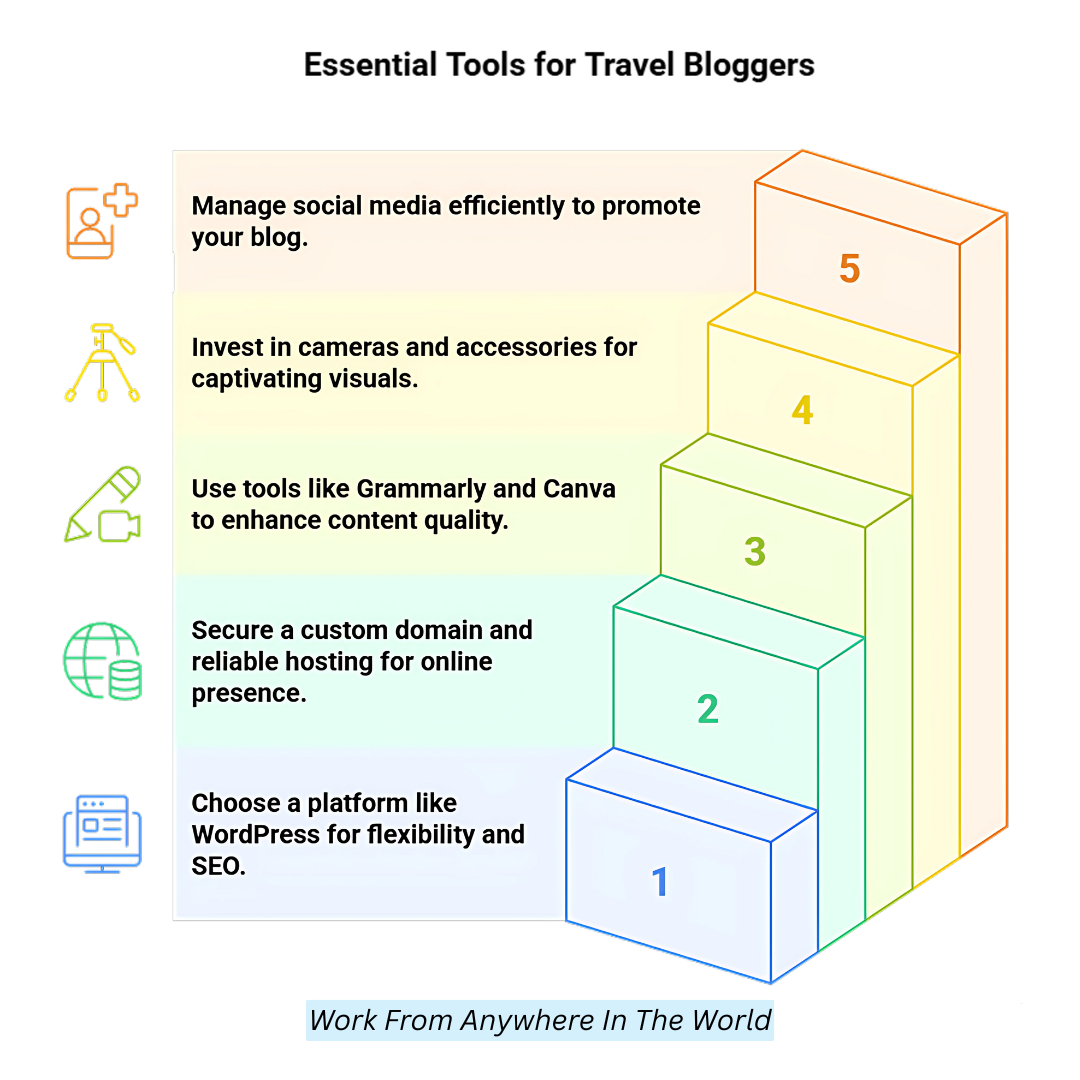
6. SEO Tools
SEO tools help your blog rank higher in search engines, attracting organic traffic. Yoast SEO (a WordPress plugin) guides you in optimizing posts with keywords and readability tips.
Google Analytics tracks visitor behaviour, so you understand what content works. Google Search Console monitors site health and indexing.
Setup requires installing plugins and linking your site to Google accounts. These tools are mostly free. Effective SEO improves your blog’s visibility, increasing the chance readers discover your travel tips and stories without paid ads, helping grow your audience sustainably.
7. Email Marketing
You can communicate with your readers directly by creating an email list. Platforms like Mailchimp or ConvertKit help create signup forms, send newsletters, and automate campaigns.
This personal connection fosters loyalty and repeat visits. Setup involves integrating signup forms into your blog and making your first email sequence.
Free plans are available to a certain number of subscribers; paid plans start at $15/month. Email marketing turns casual visitors into engaged followers, driving blog traffic, and increasing monetization opportunities such as affiliate sales or product launches.
8. Monetization & Affiliate Marketing
Affiliate programs like Amazon Associates or Booking.com let you earn commissions by recommending travel gear or accommodations.
Google AdSense places ads on your blog for passive income. Setup involves applying to affiliate programs, adding tracking links, or integrating ad code into your blog.
These are mostly free to join, but earnings depend on traffic and clicks. Monetization tools enable travel bloggers to generate income while sharing genuine recommendations, helping sustain the blog financially and invest in better content, equipment, or travel experiences.
9. Travel Planning Apps
Apps like TripIt or Google Trips organize your itineraries, bookings, and travel documents in one place.
They make travel smoother and stress-free by keeping everything easily accessible. Currency converters and translation apps help with budgeting and communication abroad.
Set up requires downloading the apps and linking your travel information. Most are free with optional premium features.
Efficient travel planning tools save time and reduce hassle, enabling you to focus on creating fresh, accurate travel content and enjoy your journeys without logistics distractions.
10. Community & Learning
Joining travel blogger groups on Facebook, Reddit, or Skillshare connects you with peers for advice, feedback, and networking.
Learning platforms offer blogging, photography, SEO, and social media marketing courses. Setup is as simple as signing up for groups or classes.
Many groups are free; courses range from $10 to $100+. Engaging with a community and continuous learning keep you motivated, informed, and improve your blog’s quality, helping you avoid common mistakes and grow faster with shared knowledge.
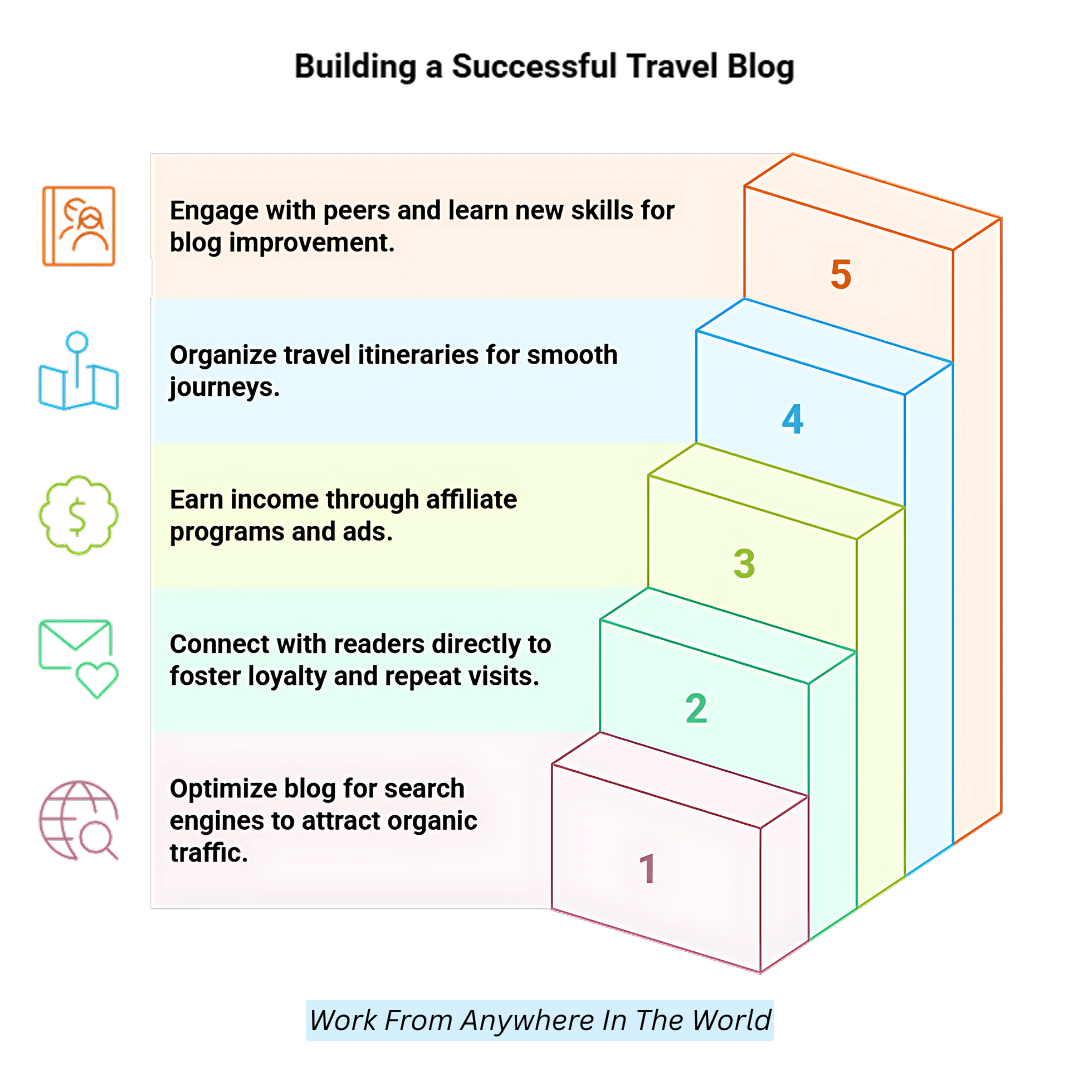
Travel Blogger Income Examples
Here are realistic examples of travel blogger income to show how people earn from blogging about travel. These figures vary depending on audience size, monetization methods, and experience level.
1. Nomadic Matt – Over $750,000/year
Nomadic Matt earns over $750,000 annually through affiliate marketing, book sales, online courses, advertising, and speaking engagements.
He has built a trusted brand focused on budget travel advice, creating a strong email list and detailed travel guides that attract millions. His diverse income streams make him one of the top travel bloggers.
2. The Blonde Abroad – $20,000–$50,000/month
Kiersten, The Blonde Abroad, earns between $20,000 and $50,000 monthly via brand sponsorships, affiliate marketing, product sales like Lightroom presets and travel guides, and ads.
She focuses on solo female travel and luxury experiences. Her business model combines travel blogging with digital product sales and courses, ensuring steady, diversified revenue.
3. Making It Anywhere – $5,000–$10,000/month
Making It Anywhere earns around $5,000 to $10,000 monthly, combining travel blogging with freelance content writing services.
The blog serves as a portfolio, helping land writing clients worldwide. This blend of blogging and freelancing boosts income steadily while sharing travel stories and remote work tips, making it a sustainable model.
4. Two Wandering Soles – $100,000+/year
Two Wandering Soles generates over $100,000 yearly through affiliate marketing, ads (via Mediavine), digital products such as ebooks, and online courses.
They emphasize ethical and sustainable travel, attracting an audience interested in responsible tourism. Their SEO-optimized content and detailed guides bring consistent traffic and monetization opportunities.
5. A Broken Backpack – $5,000–$12,000/month
A Broken Backpack earns between $5,000 and $12,000 monthly through affiliate income, brand collaborations, and ads. The blog started as a backpacking diary and expanded with travel blogging courses and digital products. This diversified approach helped build a loyal audience while creating multiple revenue streams.
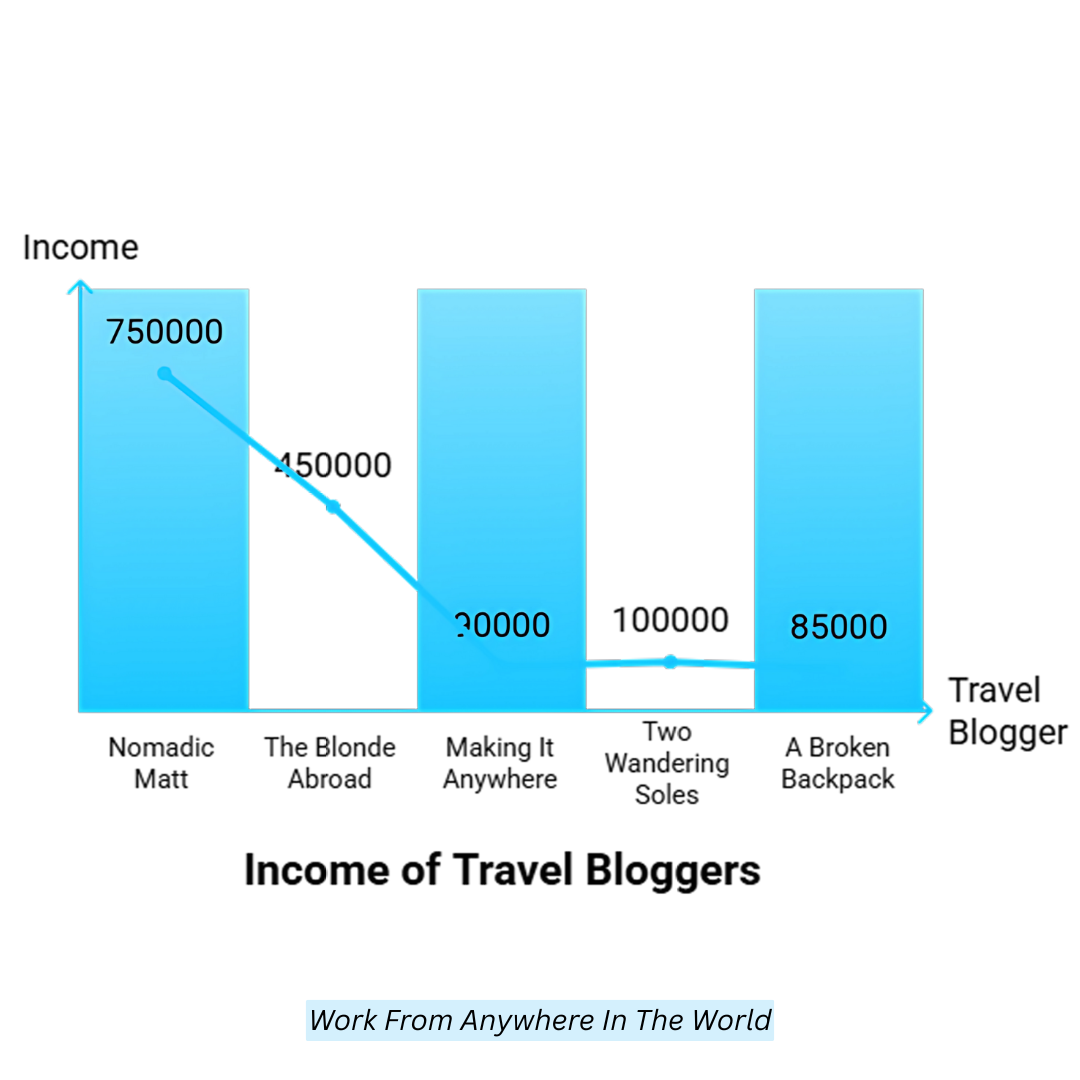
Conclusion
Now that you know how to make money from travel blogging, the journey is yours to shape. With consistency, creativity, and smart strategies, you can build a blog that funds your adventures and inspires others.
Don’t wait for the perfect moment—start today, share your story, and grow your income on the road. The world is vast, and your blog can take you everywhere.
I trust you enjoyed this article on the Ultimate Guide on How to Make Money Travel Blogging. Please stay tuned for more insightful blogs on affiliate marketing, online business, and working from anywhere in the world.
Take care!
— JeannetteZ
💬 Your Opinion Is Important To Me
Do you have thoughts, ideas, or questions? I’d love to hear from you. Please leave your comments below or email me directly at Jeannette@WorkFromAnywhereInTheWorld.com.
📚 More Work From Anywhere Reads
🚀 Ready to Build a Business You Can Run from Home
Or from Anywhere in the World?
Imagine creating income on your terms — from home, a cozy café, or wherever life takes you.
With the right tools, training, and community support, it’s entirely possible.
Start your own online business for free — no credit card needed.
Disclosure
This post may contain affiliate links. As an Amazon Associate and participant in other affiliate programs, I earn from qualifying purchases at no extra cost to you. Please read my full affiliate disclosure.

